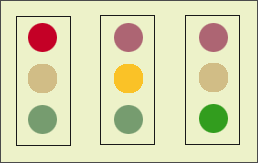However, Semiotics, or semiology, is the study of signs, symbols, and signification. It is the study of how meaning is created, not what it is.
Therefore, the below is some short definition of semiotics terms that I found in Semiotic Terminology (I found it useful, when I get lost of some part of semiotics terms, I can refer back and it's really helps a lot. =] )
Signifier: any material thing that signifies, e.g., words on a page, a facial expression, an image.
Signified: the concept that a signifier refers to.
Together, the signifier and signified make up the
So is Signifier + Signified = Sign
Symbolic (arbitrary) signs: signs where the relation between signifier and signified is purely conventional and culturally specific, e.g., most words.
Iconic signs: signs where the signifier resembles the signified, e.g., a picture.
Indexical Signs: signs where the signifier is caused by the signified, e.g., smoke signifies fire.
Denotation: the most basic or literal meaning of a sign, e.g., the word "rose" signifies a particular kind of flower.
Connotation: the secondary, cultural meanings of signs; or "signifying signs," signs that are used as signifiers for a secondary meaning, e.g., the word "rose" signifies passion.
Metonymy: a kind of connotation where in one sign is substituted for another with which it is closely associated, as in the use of Washington for the United States government or of the sword for military power.
Synecdoche(Syntagms?): a kind of connotation in which a part is used for the whole (as hand for sailor).
Myths: a combination of paradigms and syntagms that make up an oft-told story with elaborate cultural associations, e.g., the cowboy myth, the romance myth.
Codes: a combination of semiotic systems, a super system, that function as general maps of meaning, belief systems about oneself and others, which imply views and attitudes about how the world is and/or ought to be. Codes are where semiotics and social structure and values connect.
Ideologies: codes that reinforce or are congruent with structures of power. Ideology works largely by creating forms of "common sense," of the taken-for-granted in everyday life.
(Source)
From the above of semiotics's terms, we know that there are many branch out of semiotics and is quite complicated. In the following, I wish to share some interesting examples for useful to figure out the 4 sets of semiotics which could also helps in my final essay. The 4 sets are:
- Iconic/ Arbitary
- Paradigm /Syntagms
- Denotation/Connotation/Myth
- Binary opposition
Semiotics, however, it is actually structuring the very realities which they seem to 'describe' or 'stand in for'. Which meaning can be produced by socially, whether through words, colour, gesture, music, fashion, etc.
Iconic:
In Iconic , I found some interesting example which related to Vietnam War Era
Click here.
Thus after reading the examples, in my opinion that Iconic can be emotional of something and emotional can be a tool of communication.
Arbitrary:
Arbitrary could be form by signifier and signified.
Robert C. Allen noted that "Saussure stressed that the relationship between the signifier and the signified in verbal language was entirely conventional, completely arbitrary."
For example,
"Dog" is composed of the grouping of three letters ---> the Signifier
The concept of Dog that we normally imagine is an animal with 4 legs ,having sharp teeth, biting bones, having smelling sense, cute, etc. ---> the Signified
However, Saussure noted that, There is no natural or necessary connection between Dog and the concept for which it stands. Furthermore, words have no positive value. A word's meaning derives entirely from its difference from other words in the sign system of language. Words do not enter into relationships with other signs in the system in a meaningful way, they remain at the level of nonsense.
In Werner Hammerstingl's notes that,
Paradigm is
An example, pattern or standard. In grammar, a paradigm is the set of inflected forms of a word -- e.g., "artist, artist's, artists, artists'" -- or the standard pattern followed in the conjugation of a verb -- first person singular, second person singular, third person singular, first person plural, second person plural, third person plural. 2. By extension, the term also refers to the basic structure of given mind-sets or models of knowledge, as in paradigm shift.
Saussurean semiotics has developed the notion that every sign is part of a system of relationships with other signs structured through similarity and difference. These systems are called paradigms. A word thus has a paradigmatic relationship with its own inflections, new words established through prefixes and suffixes, synonyms and antonyms, etc.
For example:
 |
| A Paradigm of Colored Lights |
While Syntagms are:
the combination elements of Paradigm do not necessarily have meaning in and of themselves. Most often they take on meaning as they are combined into more complex patterns of signs called syntagms.
For example:
 |
| Syntagms Formed from the Paradigm |
(Source)
Denotation , Connotation & Myth:
An example for Denotation and Connotation
click here
Binary Opposition:
A binary opposition is a binary relation in which one correlate is marked and the other unmarked. There are two logically distinct types of markedness. In markedness of the general type, there is an attribute of the marked correlate that is not an attribute of the unmarked correlate. In markedness of the specific type, the correlates of a binary relation share an attribute where the attribute of the marked correlate is in some sense more or less than the attribute of the unmarked correlate. A binary opposition may be marked in different ways, for different attributes.
(Source)
In my opinion, binary opposition is just like 反义词 in mandrin which a set off against one another.


No comments:
Post a Comment